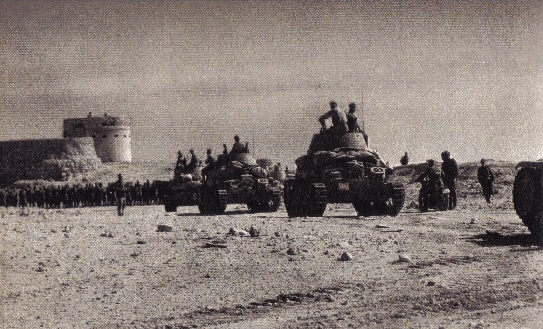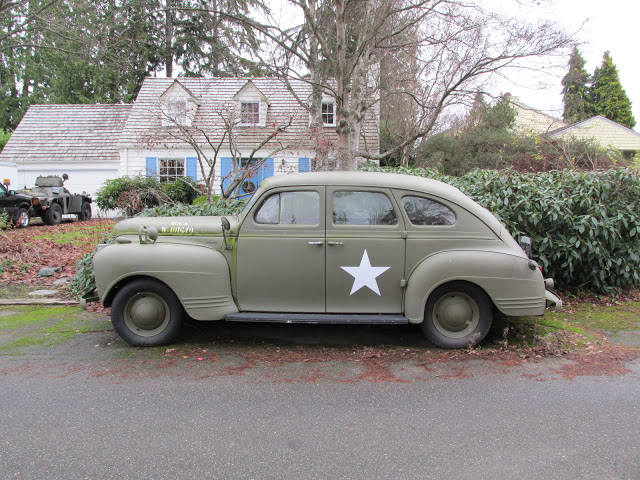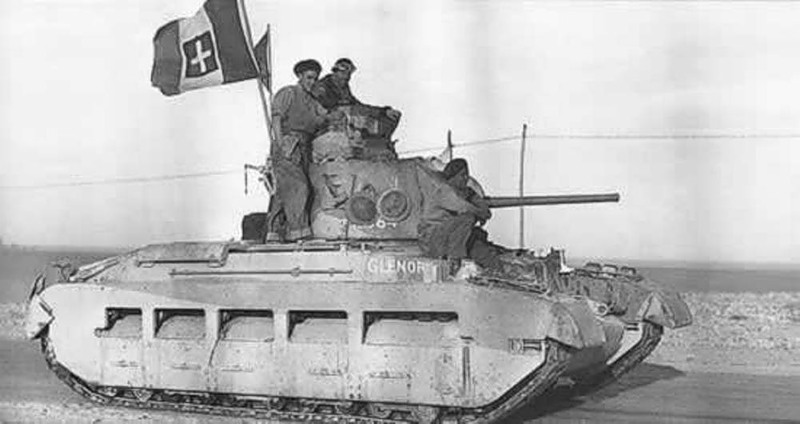Friday 24 January 1941
East African Campaign: The Italian 4th and 5th Indian Divisions continue advancing past Keru Gorge, abandoned by the Italians. They are proceeding in the direction of Agordat. On the Kenya front, Lieutenant General Cunningham's forces move alongside South African troops into the Moyale frontier districts. Cunningham has 75,000 men at his disposal, though most are locals from the colonies.
European Air Operations: Activity remains light due to the weather. The Luftwaffe barely appears over Great Britain at all during the day and night, and the RAF is grounded as well.
 |
| HMS King George V arriving in the Chesapeake Bay, 24 January 1941. The battleship brings Lord Halifax to the United States. |
Battle of the Atlantic: U-123 (Kptlt. Karl-Heinz Moehle) torpedoes and sinks 1570 ton Norwegian freighter Vespasian in the shipping lanes northwest of Ireland. There are 18 deaths. Vespasian is a straggler from Convoy OB 276 due to the weather.
British 1096 ton freighter Corheath hits a mine and sinks near the Botany Buoy in the Thames Estuary. There are three deaths.
British 6405 ton freighter Tasmania hits a mine off Rattray Head, Aberdeenshire. The weather is horrendous and the stricken steamer cannot make port anywhere nearby, but instead must head back to Methil where she makes port.
Finnish 4028 ton freighter Wirta runs aground at Skerjafjord, Iceland. The ship is wrecked, but the crew is saved.
German supply ship Nordmark meets the cruiser Admiral Scheer in the South Atlantic and replenishes it. The Scheer continues to travel in company with captured Norwegian tanker Sandefjord, but the pickings have been lean for the Scheer up to this point.
Convoy OB 278 departs from Liverpool.
Royal Canadian Navy minesweeper HMAS Lismore (J-145, Lt. Stanley H. Crawford) is commissioned and HMAS Gawler is laid down.
U-562 launched.
 |
| Australian soldiers using captured Italian M11/40 tanks and M11/39 tanks (note the white kangaroos on the tanks' sides) watch Tobruk burn, 24 January 1941 (© IWM (E 1766). |
The Italians for the first time in the campaign show some real fight, and fierce battles break out around the outskirts of Derna. Babini sends about fifty M13/40 tanks against the advancing 7th Hussars as they are advancing to cut the important Derna/Mechili road. The new Italian tanks give a good account of themselves against British Mk. VIs, forcing the advanced British elements to pull back and call for help. The request is ignored for a time by the 2nd Royal Tank Regiment (2 RTR), perhaps partly because the Italians heretofore have not been fighting and the feeling may simply be that nothing regarding the Italians could have much urgency. Eventually, the British tankers return with Matildas, 2-pounders and even 25-pounder field guns. This time, they route the Italian armor, sending them retreating into an ambush and destroying about 8 of the Italian tanks while capturing another. For their pains, the British lose a cruiser tank and six light tanks. The reasonably equal losses indicate how hard the fighting has become. However, the advantage still lies with the British, as the Italians are forced to retreat to Mechili.
Supporting the Babini Group is the Italian 60th Infantry Division Sabratha, which holds the line from Derna to Mechili. There, the 2/11th Australian Battalion also finds its going blocked for the moment. It calls for reinforcements.
At Malta, the islanders are still recovering from the massive air raids by the Luftwaffe's Fliegerkorps X during the "Illustrious Blitz." The aircraft carrier HMS Illustrious has left, but many unexploded bombs remain to be defused.
The Luftwaffe continues to attack Illustrious as she heads for Alexandria. Fliegerkorps X sends 30 aircraft to bomb it about 130 miles north of Benghazi. The Stukas and Junkers Ju 88s manage some near misses but cause little damage to the battleships, cruisers, and destroyers escorting the stricken aircraft carrier away. In fact, the Luftwaffe does not even spot the carrier and must content itself with attacking vessels better able to defend themselves.
 |
| Italian armor with For Mechili in the background. 1941-42. |
Knowing its position, the Royal Navy in the area organizes four cruisers into Force V to hunt down the raider. They have known about raiders in this part of the world for some time, and the Christmas raid on Naaru inflamed their passion to track them down. Unfortunately for the British, they have no long-range aerial reconnaissance available and Captain Rogge in the Atlantis gets away. This incident does impel local Royal Navy authorities to give greater priority to allocating forces in that region of the Indian Ocean, but the British do not have many available assets to spare at this time.
Anglo/US Relations: Lord Halifax, erstwhile Foreign Secretary, arrives in the Chesapeake Bay aboard the battleship King George V, having departed Scotland on 15 January. He is in the United States to replace the deceased Lord Lothian as ambassador to the United States. At Winston Churchill's urging, President Roosevelt is there to greet him. Few men in history have had as honored a trans-Atlantic journey on both ends as Halifax, considering that the King, Queen, and Churchill saw him off from Scapa Flow and Roosevelt was there to greet him upon his arrival.
Anglo/Australian Relations: Prime Minister Robert Menzies flies from Melbourne for a visit to England, taking off in a flying boat from Rose Bay, Sydney. The first major stop is Darwin, which will take two days to reach. Due to the war situation, he will take a roundabout journey through central Africa and thence up to Lisbon. The entire journey to London will take about a month.
Menzies' mission is to impress upon the British high command the perilous situation in the Pacific Theater. He wants better defenses in Singapore and more wartime industry sited in Australia. The timing of the trip is striking, coinciding with the battles of Australian troops in North Africa.
German/Spanish Relations: The Germans remain optimistic that they can convince the Spanish leader Francisco Franco to join the Axis. Foreign Minister Ribbentrop gets involved in this effort, which so far has gone nowhere and which shows no signs of changing Franco's attitude of military neutrality.
 |
| Some unknown person in Seattle, Washington owns this classic Plymouth Army P11 staff car of 1941 and appears to keep it driveable. There's another classic military vehicle in the driveway, so someone is really into World War II-era vehicles. (Photo: Ryan Haarsager). |
is believed easily possible that hostilities would be initiated by a surprise attack upon the fleet or the naval base at Pearl Harbor.Knox foresees "inherent possibilities of a major disaster" and lists the following "dangers envisaged in order of their importance and probability," to wit:
air attackKnox suggests that army and navy plans be coordinated in the event of such an air raid against Hawaii.
torpedo plane attack
sabotage
submarine attack
mining
bombardment by gunfire.
 |
| The Jackson, Mississippi Daily News, 24 January 1941. |
Indochina: Thai bombers raid the French airbase at Angkor, Cambodia, near Siem Riep. This is the final battle of the conflict.
At this point, the Japanese decide they have seen enough squabbling over territory they covet, so they step in as mediators. The Thais accept Japanese mediation in the conflict with the French colonial administrators despite US warnings that the Japanese are simply managing events for their own benefit. The two parties, Thailand and Vichy France, enter into negotiations on Japanese cruiser Vatori, which arrives in Saigon on or about this date. Naturally, the Japanese have a seat at the table and guide things to benefit the Thais.
Antarctica: USMS North Star, an Arctic supply ship, arrives to pick up the crew of Admiral Richard E. Byrd's third expedition to Antarctica at West Base.
Holocaust: A ghetto is opened in Sochaczew, Poland, with the Jews having to leave their homes in the town and get to the ghetto within 24 hours. The Judenrat provides ten carts for 2000 people, limiting to the extreme the number of personal possessions that families can take. Many notice the actions of the Judenrat, whose members appropriate for themselves and their families the best lodgings and manage to travel more comfortably.
Future History: Today is quite a day in the world of music, though nobody will realize if for about 30 years.
Neil Leslie Diamond is born in Brooklyn, New York. He attends Erasmus Hall High School, where one of his classmates is Barbra Streisand. On his 16th birthday, Neil receives a guitar as a gift, and he develops a love for singing at a summer camp in upstate New York. He begins writing poetry to pick up girls, and this informs his music, and he begins writing songs. Sunbeam Music Publishing offers him a temporary job writing songs, so he drops out of NYU. However, he is not retained after the temporary gig ends, so he begins recording demos. He writes several hit songs recorded by The Monkees, including "I'm a Believer," "A Little Bit Me, a Little Bit You," and others. Other big artists like Elvis Presley begin recording his songs, and he begins to establish himself as a performer as well. After signing with Uni (Universal) Records in 1968, he gains some traction performing, and in 1969 begins a string of major hits with "Sweet Caroline." He becomes one of the top performers of the '70s, and turns to films in 1980 with "The Jazz Singer." His song "Heartlight" inspired by the hit movie "E.T. The Extra-Terrestrial" in 1982 becomes a huge hit. Neil Diamond remains a household name and continues to perform.
Aaron Neville is born in New Orleans, Louisiana. Neville records with brothers Art, Charles and Cyril as The Neville Brothers, and later becomes a top solo act. His hit singles include "Tell it Like It Is," "Don't Know Much" with Linda Ronstadt, and "Everybody Plays the Fool," among many others. Aaron Neville continues to perform and release albums.
Michael Chapman is born in Leeds, Yorkshire, England. He becomes a professional musician, writing songs and performing in the "progressive music scene" in England. Chapman continues to perform and has recorded over 40 albums to date.
 |
| Destroyers USS Butler and Gherardi under construction at the Philadelphia Navy Yard, 24 January 1941. |
January 1941
January 1, 1941: Muselier ArrestedJanuary 2, 1941: Camp Categories
January 3, 1941: Liberty Ships
January 4, 1941: Aussies Take Bardia
January 5, 1941: Amy Johnson Perishes
January 6, 1941: Four Freedoms
January 7, 1941: Pearl Harbor Plans
January 8, 1941: Billions For Defense
January 9, 1941: Lancasters
January 10, 1941: Malta Convoy Devastation
January 11, 1941: Murzuk Raid
January 12, 1941: Operation Rhubarb
January 13, 1941: Plymouth Blitzed
January 14, 1941: V for Victory
January 15, 1941: Haile Selassie Returns
January 16, 1941: Illustrious Blitz
January 17, 1941: Koh Chang Battle
January 18, 1941: Luftwaffe Pounds Malta
January 19, 1941: East African Campaign Begins
January 20, 1941: Roosevelt 3rd Term
January 21, 1941: Attack on Tobruk
January 22, 1941: Tobruk Falls
January 23, 1941: Pogrom in Bucharest
January 24, 1941: Tank Battle in Libya
January 25, 1941: Panjiayu Tragedy
January 26, 1941: Churchill Working Hard
January 27, 1941: Grew's Warning
January 28, 1941: Ho Chi Minh Returns
January 29, 1941: US Military Parley With Great Britain
January 30, 1941: Derna Taken
January 31, 1941: LRDG Battered
2020

No comments:
Post a Comment